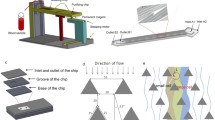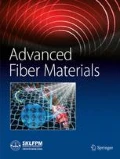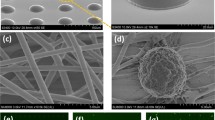Abstract
Detection of circulating tumor cells (CTCs) plays an important role in early diagnosis of cancer and personalized therapy. However, isolated CTCs, especially those captured by positive sorting methods, are difficult to culture in subsequent assays because the cells have to be labeled or attached to a substrate for separation. In this study, a negative sorting method has been developed for isolation of CTCs through a microfluidic platform integrated with streptavidin-functionalized electrospun polylactic-co-glycolic acid nanofibers. Through the specific biotin-streptavidin interaction, the device is able to sort out biotinylated anti-CD45 antibody-labeled white blood cells (WBCs) and enrich A549 human cancer cells from the blood or CTCs from patient suffering non-small cell lung cancer. We demonstrate that the WBC capture efficiency is as high as 97.0%, and the recovery rate of cancer cells reaches up to 97.5%. CTCs are enumerated from blood samples of patients suffering lung carcinoma. The number of CTCs increased with the progression of NCCN TNM stages and showed statistically significant difference between stage I and later stages. These results suggest that the integrated negative sorting device is promising to be used for diagnosis of cancer.
Graphic Abstract







Similar content being viewed by others

References
Alix-Panabières C, Schwarzenbach H, Pantel K. Circulating tumor cells and circulating tumor DNA. Annu Rev Med. 2012;63:199.
Plaks V, Koopman CD, Werb Z. Circulating tumor cells. Science. 2013;341:1186.
Wang S, Liu K, Liu J, Yu ZT-F, Xu X, Zhao L, Lee T, Lee EK, Reiss J, Lee Y-K, Chung LWK, Huang J, Rettig M, Seligson D, Duraiswamy KN, Shen CK-F, Tseng H-R. Highly efficient capture of circulating tumor cells by using nanostructured silicon substrates with integrated chaotic micromixers. Angew Chem Int Ed. 2011;50:3084.
Liu H, Liu X, Meng J, Zhang P, Yang G, Su B, Sun K, Chen L, Han D, Wang S, Jiang L. Hydrophobic interaction-mediated capture and release of cancer cells on thermoresponsive nanostructured surfaces. Adv Mater. 2013;25:922.
Chen L, Liu X, Su B, Li J, Jiang L, Han D, Wang S. Aptamer-mediated efficient capture and release of t lymphocytes on nanostructured surfaces. Adv Mater. 2011;23:4376.
Liu H, Li Y, Sun K, Fan J, Zhang P, Meng J, Wang S, Jiang L. Dual-responsive surfaces modified with phenylboronic acid-containing polymer brush to reversibly capture and release cancer cells. J Am Chem Soc. 2013;135:7603.
Li Y, Lu Q, Liu H, Wang J, Zhang P, Liang H, Jiang L, Wang S. Antibody-modified reduced graphene oxide films with extreme sensitivity to circulating tumor cells. Adv Mater. 2015;27:6848.
Zhang F, Jiang Y, Liu X, Meng J, Zhang P, Liu H, Yang G, Li G, Jiang L, Wan L-J, Hu J-S, Wang S. Hierarchical nanowire arrays as three-dimensional fractal nanobiointerfaces for high efficient capture of cancer cells. Nano Lett. 2016;16:766.
Liu X, Wang S. Three-dimensional nano-biointerface as a new platform for guiding cell fate. Chem Soc Rev. 2014;43:2385.
Zhang P, Chen L, Xu T, Liu H, Liu X, Meng J, Yang G, Jiang L, Wang S. Programmable fractal nanostructured interfaces for specific recognition and electrochemical release of cancer cells. Adv Mater. 2013;25:3566.
Ouyang J, Chen M, Bao WJ, Zhang QW, Wang K, Xia XH. Morphology controlled poly(aminophenylboronic acid) nanostructures as smart substrates for enhanced capture and release of circulating tumor cells. Adv Funct Mater. 2015;25:6122.
Armbrecht L, Rutschmann O, Szczerba BM, Nikoloff J, Aceto N, Dittrich PS. Quantification of protein secretion from circulating tumor cells in microfluidic chambers. Adv Sci. 2020;7:1903237.
Zhang Q, Rong Y, Yi K, Huang L, Chen M, Wang F. Circulating tumor cells in hepatocellular carcinoma: single-cell based analysis, preclinical models, and clinical applications. Theranostics. 2020;10:12060.
Huang C, Yang G, Ha Q, Meng J, Wang S. Multifunctional, “Smart” particles engineered from live immunocytes: toward capture and release of cancer cells. Adv Mater. 2015;27:310.
Sun N, Wang J, Ji L, Hong S, Dong J, Guo Y, Zhang K, Pei R. A cellular compatible chitosan nanoparticle surface for isolation and in situ culture of rare number CTCs. Small. 2015;11:5444.
Ding P, Wang Z, Wu Z, Zhu W, Liu L, Sun N, Pei R. Aptamer-based nanostructured interfaces for the detection and release of circulating tumor cells. J Mater Chem B. 2020;8:3408.
Mishra A, Dubash TD, Edd JF, Jewett MK, Garre SG, Karabacak NM, Rabe DC, Mutlu BR, Walsh JR, Kapur R, Stott SL, Maheswaran S, Haber DA, Toner M. Ultrahigh-throughput magnetic sorting of large blood volumes for epitope-agnostic isolation of circulating tumor cells. Proc Natl Acad Sci. 2020;117:16839.
Safarpour H, Dehghani S, Nosrati R, Zebardast N, Alibolandi M, Mokhtarzadeh A, Ramezani M. Optical and electrochemical-based nano-aptasensing approaches for the detection of circulating tumor cells (CTCs). Biosens Bioelectron. 2020;148:111833.
Thege FI, Lannin TB, Saha TN, Tsai S, Kochman ML, Hollingsworth MA, Rhim AD, Kirby BJ. Microfluidic immunocapture of circulating pancreatic cells using parallel epcam and muc1 capture: Characterization, optimization and downstream analysis. Lab Chip. 2014;14:1775.
Sarioglu AF, Aceto N, Kojic N, Donaldson MC, Zeinali M, Hamza B, Engstrom A, Zhu H, Sundaresan TK, Miyamoto DT, Luo X, Bardia A, Wittner BS, Ramaswamy S, Shioda T, Ting DT, Stott SL, Kapur R, Maheswaran S, Haber DA, Toner M. A microfluidic device for label-free, physical capture of circulating tumor cell clusters. Nat Methods. 2015;12:685.
Chen C, Wu Z, Ding P, Sun N, Liu H, Chen Y, Wang Z, Pei R. Peptide NGR modified TiO2 nanofiber substrate for circulating tumor cells capture. Adv Fiber Mater. 2020;2:186.
Wang Z, Sun N, Liu M, Cao Y, Wang K, Wang J, Pei R. Multifunctional nanofibers for specific purification and release of CTCs. ACS Sens. 2017;2:547.
Liu H, Wang ZL, Chen CC, Ding P, Sun N, Pei RJ. Dual-antibody modified PLGA nanofibers for specific capture of epithelial and mesenchymal CTCs. Colloids Surf B. 2019;181:143.
Xu G, Tan Y, Xu T, Yin D, Wang M, Shen M, Chen X, Shi X, Zhu X. Hyaluronic acid-functionalized electrospun plga nanofibers embedded in a microfluidic chip for cancer cell capture and culture. Biomater Sci. 2017;5:752.
Zhao YL, Fan ZY, Shen MW, Shi XY. Capturing hepatocellular carcinoma cells using lactobionic acid-functionalized electrospun polyvinyl alcohol/polyethyleneimine nanofibers. RSC Adv. 2015;5:70439.
Zhao YL, Fan ZY, Shen MW, Shi XY. Hyaluronic acid-functionalized electrospun polyvinyl alcohol/polyethyleneimine nanofibers for cancer cell capture applications. Adv Mater Interfaces. 2015;2:1500256.
Zhao YL, Zhu XY, Liu H, Luo Y, Wang SG, Shen MW, Zhu MF, Shi XY. Dendrimer-functionalized electrospun cellulose acetate nanofibers for targeted cancer cell capture applications. J Mater Chem B. 2014;2:7384.
Xia W, Li H, Li Y, Li M, Fan J, Sun W, Li N, Li R, Shao K, Peng X. In vivo coinstantaneous identification of hepatocellular carcinoma circulating tumor cells by dual-targeting magnetic-fluorescent nanobeads. Nano Lett. 2021;21:634.
Dieguez L, Winter MA, Pocock KJ, Bremmell KE, Thierry B. Efficient microfluidic negative enrichment of circulating tumor cells in blood using roughened PDMS. Analyst. 2015;140:3565.
Khoo BL, Grenci G, Lim YB, Lee SC, Han J, Lim CT. Expansion of patient-derived circulating tumor cells from liquid biopsies using a CTC microfluidic culture device. Nat Protoc. 2018;13:34.
Kang Y-T, Hadlock T, Lo T-W, Purcell E, Mutukuri A, Fouladdel S, Raguera MDS, Fairbairn H, Murlidhar V, Durham A, McLean SA, Nagrath S. Dual-isolation and profiling of circulating tumor cells and cancer exosomes from blood samples with melanoma using immunoaffinity-based microfluidic interfaces. Adv Sci. 2020;7:2001581.
Agerbæk MØ, Bang-Christensen SR, Yang M-H, Clausen TM, Pereira MA, Sharma S, Ditlev SB, Nielsen MA, Choudhary S, Gustavsson T, Sorensen PH, Meyer T, Propper D, Shamash J, Theander TG, Aicher A, Daugaard M, Heeschen C, Salanti A. The VAR2CSA malaria protein efficiently retrieves circulating tumor cells in an EpCAM-independent manner. Nat Commun. 2018;9:3279.
Kim TH, Wang Y, Oliver CR, Thamm DH, Cooling L, Paoletti C, Smith KJ, Nagrath S, Hayes DF. A temporary indwelling intravascular aphaeretic system for in vivo enrichment of circulating tumor cells. Nat Commun. 2019;10:1478.
Chen J, Yu L, Li Y, Cuellar-Camacho JL, Chai Y, Li D, Li Y, Liu H, Ou L, Li W, Haag R. Biospecific monolayer coating for multivalent capture of circulating tumor cells with high sensitivity. Adv Funct Mater. 2019;29:1808961.
Dong Z, Tang C, Zhao L, Xu J, Wu Y, Tang X, Zhou W, He R, Zhao R, Xu L, Zhang Z, Fang X. A microwell-assisted multiaptamer immunomagnetic platform for capture and genetic analysis of circulating tumor cells. Adv Healthcare Mater. 2018;7:1801231.
Hou S, Zhao LB, Shen QL, Yu JH, Ng C, Kong XJ, Wu DX, Song M, Shi XH, Xu XC, OuYang WH, He RX, Zhao XZ, Lee T, Brunicardi FC, Garcia MA, Ribas A, Lo RS, Tseng HR. Polymer nanofiber-embedded microchips for detection, isolation, and molecular analysis of single circulating melanoma cells. Angew Chem, Int Ed. 2013;52:3379.
Wang MY, Xiao YC, Lin LZ, Zhu XY, Du LF, Shi XY. A Microfluidic chip integrated with hyaluronic acid-functionalized electrospun chitosan nanofibers for specific capture and nondestructive release of CD44-overexpressing circulating tumor cells. Bioconjugate Chem. 2018;29:1081.
Xiao YC, Shen MW, Shi XY. Design of functional electrospun nanofibers for cancer cell capture applications. J Mater Chem B. 2018;6:1420.
Xiao YC, Wang MY, Lin LZ, Du LF, Shen MW, Shi XY. Integration of aligned polymer nanofibers within a microfluidic chip for efficient capture and rapid release of circulating tumor cells. Mater Chem Front. 2018;2:891.
Xiao YC, Wang MY, Lin LZ, Du LF, Shen MW, Shi XY. Specific capture and release of circulating tumor cells using a multifunctional nanofiber-integrated microfluidic chip. Nanomedicine. 2019;14:183.
Sun N, Liu M, Wang J, Wang Z, Li X, Jiang B, Pei R. Chitosan nanofibers for specific capture and nondestructive release of CTCs assisted by pCBMA brushes. Small. 2016;12:5090.
Huang W, Xiao Y, Shi X. Construction of electrospun organic/inorganic hybrid nanofibers for drug delivery and tissue engineering applications. Adv Fiber Mater. 2019;1:32.
Jurasek M, Goselova S, Miksatkova P, Holubova B, Vysatova E, Kuchar M, Fukal L, Lapcik O, Drasar P. Highly sensitive avidin-biotin ELISA for detection of nandrolone and testosterone in dietary supplements. Drug Test Anal. 2017;9:553.
Pan JF, Liu NH, Shu LY, Sun H. Application of avidin-biotin technology to improve cell adhesion on nanofibrous matrices. J Nanobiotechnol. 2015;13:37.
Hyun KA, Lee TY, Jung HI. Negative enrichment of circulating tumor cells using a geometrically activated surface interaction chip. Anal Chem. 2013;85:4439.
Tsao SC, Vaidyanathan R, Dey S, Carrascosa LG, Christophi C, Cebon J, Shiddiky MJ, Behren A, Trau M. Capture and on-chip analysis of melanoma cells using tunable surface shear forces. Sci Rep. 2016;6:19709.
Yoon HJ, Shanker A, Wang Y, Kozminsky M, Jin Q, Palanisamy N, Burness ML, Azizi E, Simeone DM, Wicha MS, Kim J, Nagrath S. Tunable thermal-sensitive polymer-graphene oxide composite for efficient capture and release of viable circulating tumor cells. Adv Mater. 2016;28:4891.
Zheng FY, Wang SG, Wen SH, Shen MW, Zhu MF, Shi XY. Characterization and antibacterial activity of amoxicillin-loaded electrospun nano-hydroxyapatite/poly(lactic-co-glycolic acid) composite nanofibers. Biomaterials. 2013;34:1402.
Gan ZB, Marquardt RR. Colorimetric competitive inhibition method for the quantitation of avidin, streptavidin and biotin. J Biochem Biophys Methods. 1999;39:1.
Schiestel T, Brunner H, Tovar GEM. Controlled surface functionalization of silica nanospheres by covalent conjugation reactions and preparation of high density streptavidin nanoparticles. J Nanosci Nanotechnol. 2004;4:504.
Zhao YL, Wang SG, Guo QS, Shen MW, Shi XY. Hemocompatibility of electrospun halloysite nanotube and carbon nanotube-doped composite poly(lactic-co-glycolic acid) nanofibers. J Appl Polym Sci. 2013;127:4825.
Tanaka T, Ishikawa T, Numayama-Tsuruta K, Imai Y, Ueno H, Matsuki N, Yamaguchi T. Separation of cancer cells from a red blood cell suspension using inertial force. Lab Chip. 2012;12:4336.
Hou JM, Krebs MG, Lancashire L, Sloane R, Backen A, Swain RK, Priest LJC, Greystoke A, Zhou C, Morris K, Ward T, Blackhall FH, Dive C. Clinical significance and molecular characteristics of circulating tumor cells and circulating tumor microemboli in patients with small-cell lung cancer. J Clin Oncol. 2012;30:525.
Ettinger DS, Wood DE, Aisner DL, Akerley W, Bauman J, Chirieac LR, Dmico TA, DeCamp MM, Dilling TJ, Dobelbower M, Doebele RC, Govindan R, Gubens MA, Hennon M, Horn L, Komaki R, Lackner RP, Lanuti M, Leal TA, Leisch LJ, Lilenbaum R, Lin J, Loo BW, Martins R, Otterson GA, Reckamp K, Riely GJ, Schild SE, Shapiro TA, Stevenson J, Swanson SJ, Tauer K, Yang SC, Gregory K, Hughes M. Non-small cell lung cancer, version 5.2017 clinical practice guidelines in oncology. J Natl Compr Cancer Netw. 2017;15:504.
Acknowledgements
This research was financially supported by the National Natural Science Foundation of China (21405012 and 81761148028), the Science and Technology Commission of Shanghai Municipality (19XD1400100 and 20DZ2254900), the Shanghai Education Commission through the Shanghai Leading Talents Program, and the 111 Project (BP0719035).
Author information
Authors and Affiliations
Corresponding authors
Ethics declarations
Conflict of interest
The authors declare no competing financial interest.
Supplementary Information
Below is the link to the electronic supplementary material.
Rights and permissions
About this article
Cite this article
Wang, M., Tan, Y., Li, D. et al. Negative Isolation of Circulating Tumor Cells Using a Microfluidic Platform Integrated with Streptavidin-Functionalized PLGA Nanofibers. Adv. Fiber Mater. 3, 192–202 (2021). https://doi.org/10.1007/s42765-021-00075-x
Received:
Accepted:
Published:
Issue Date:
DOI: https://doi.org/10.1007/s42765-021-00075-x



